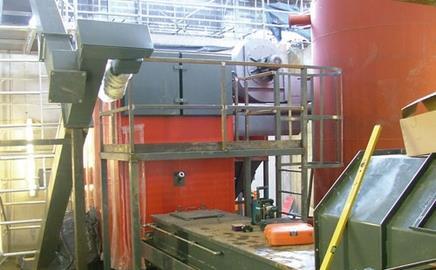When Nightingale Associates was appointed to design the £22m Rhondda Valley hospital in South Wales, a 108-bed facility due for completion in April 2008, it wasn’t aware that it was going to end up installing the largest biomass boiler the NHS has seen.
But with help from Wood Energy, supplier and installer to the Welsh assembly, it did just that two weeks ago. Project architect Jamie Brewster and Marc Howell, business development manager at Wood Energy, talk us through the process.
Why biomass?
Brewster At the start, the NHS trust asked us to respond to green issues. Rather than architectural solutions, we investigated the wider benefits of biomass for heating, and introduced them to the client. It’s a zero-carbon resource and offers impressive potential cost benefits for a 24/7 facility.
How did Wood Energy get involved?
Howell Through Nightingale’s M&E engineer, RW Gregory, who’d seen our work at the Welsh assembly. We invited the architect and client to see our installations and made a presentation of our proposal.
Brewster They really knew what they were on about. There was no competitive tendering and, although we didn’t nominate a subcontractor, we insisted in the contract on having Binder biomass boilers, which were featured in the presentation. Wood Energy was the only subcontractor in the UK that could supply and install them.
What was the most challenging aspect of the project?
Brewster That’s easy. Convincing the NHS trust to be guinea pigs and go with an experimental technology. There was no precedent for this and Mark was fundamental in getting them to agree.
Howell Persuading the client to choose the fuel option that would give them greatest flexibility – effectively future-proofing the installation. Rhondda’s boiler can use both pellets and timber, wet and dry. It’s a larger outlay, but a better long-term solution. The installed system, all in, cost about £250,000.
How was the design developed?
Brewster Entirely in conjunction with Wood Energy. We were new to this, too, and had no direct experience of the space requirements, the layout of basement areas for biomass and the construction logistics. They advised on making sure the NHS trust was not tied into only one form of biomass supply – all advice was given free of charge initially. They knew it was a ticket for them, but they really made the effort. They even helped in securing grant funding.
Howell We worked with RW Gregory, looking at the load profiles of the hospital so we could work out the boiler size and type, and also to get an understanding of the peaks and troughs in demand that might occur when the hospital is in use. We used a “stepped grate” combustion system with an output of 3MW.
What were the logistics of installation?
Brewster The contractor wrongly assumed it could get the Binder in without taking it through the roof, but the roof did end up coming off again. The boiler comes in several sections – an 11m ram conveyor, a 3 × 3 × 2m boiler on legs and a water tank more than 3m tall. Rotating Archimedes screws move the generated ash to holding tanks at ground level for disposal. It’s a serious piece of machinery.
Was the contract value engineered?
Brewster When we were forced to value engineer, we did it elsewhere on the project. The decision was made that there would be no cutting of corners for this element.
Howell In fact, if anything, it went the opposite way. The ash removal system was originally a low-specification one. The client ended up asking for an additional Archimedes screw to go in so the ash could be delivered to ground level holding tanks mechanically.
And what about the finished thing?
Brewster It hasn’t been tested yet, but it’s in and we’re excited about it. The key point is whether it performs as promised six months after the building is in use.
Howell It’s early days yet, as it hasn’t been commissioned. We’ll have to wait and see.
Topics
Specifier 16 March 2007
- 1
- 2
- 3
- 4
 Currently reading
Currently readingHelp me, Rhondda
- 5
- 6
- 7
- 8
- 9
- 10
- 11
- 12
- 13



































No comments yet